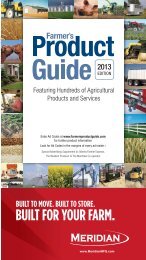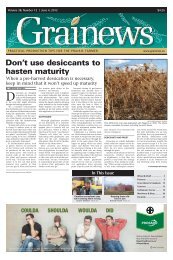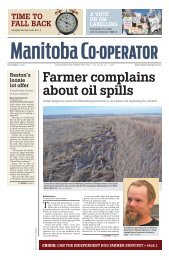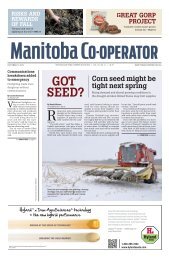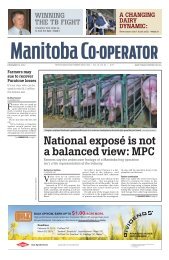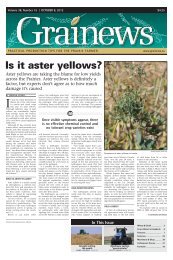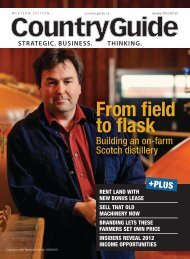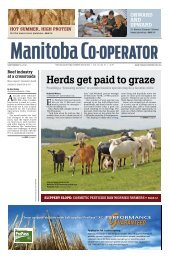MARKETING
MARKETING
MARKETING
Create successful ePaper yourself
Turn your PDF publications into a flip-book with our unique Google optimized e-Paper software.
m a n a g e m e n t<br />
Minimize your fertilizer price<br />
Increasingly, it pays to use the same skills when buying your<br />
nitrogen as when you’re selling your crops<br />
By Gerald Pilger<br />
ne of the biggest decisions farmers<br />
face each year is when should they<br />
price their fertilizer needs. Not only<br />
is fertilizer the biggest input expense<br />
in many crops, but prices can change<br />
dramatically in a relatively short period of time.<br />
Purchasing at the “wrong” time (i.e. when fertilizer<br />
prices are high) can seriously impact the farm’s<br />
financial situation. But how can a farmer know<br />
when the time is right?<br />
Here are four strategies to consider in the new era<br />
of increasingly volatile fertilizer prices.<br />
1. Pre-buy<br />
Pre-buying fertilizer months before it is required<br />
has become standard practice for most growers, with<br />
the goal of taking advantage of the seasonal nature<br />
of fertilizer prices.<br />
In most years, fertilizer prices are lowest in the late<br />
summer or fall. Growers with fertilizer storage capacity<br />
and available cash or credit can save money by purchasing<br />
in this time period. However, this is not always<br />
the case. Growers who bought their fertilizer in the fall<br />
of 2008 found they paid nearly twice as much as those<br />
who waited to purchase theirs in the spring of 2009.<br />
That year, the commodity price crash was largely<br />
responsible for the sharp drop in fertilizer demand<br />
and prices between fall and spring.<br />
On the other hand, in the spring of 2012 fertilizer<br />
prices shot up by more than 50 per cent in three<br />
weeks at seeding time, largely due to a shortage of<br />
supply. In fact some growers simply could not get as<br />
much fertilizer as they intended to use at any price.<br />
As well, many farmers experienced delays in<br />
delivery of fertilizer even though they had pre-paid<br />
for all they needed.<br />
These are all symptoms of an increasingly volatile<br />
fertilizer market, and in light of this, it’s easy to see<br />
why combining pre-buying with on-farm storage is<br />
becoming common practice, with growers trying to<br />
build as much certainty into their fertilizer supply as<br />
possible.<br />
At Minnesota State University, agricultural economist<br />
Mike Boland says there are a number of factors<br />
which impact fertilizer prices. Factors which can<br />
affect fertilizer prices include crop prices, crop supply<br />
and demand, expected fertilizer supply and demand,<br />
natural gas costs, exchange rates, transportation<br />
costs, government policy decisions, and consolidation<br />
within the fertilizer industry.<br />
Boland also emphasizes that fertilizer is now a<br />
globally traded commodity, and farmers and fertilizer<br />
retailers have very little pricing power.<br />
2. Lock in a Profit margin<br />
Jonathon Driedger, a market analyst with Farm-<br />
Link Marketing Solutions, suggests growers should<br />
be looking to lock in a profitable margin rather than<br />
simply trying to pick the lowest fertilizer prices.<br />
Driedger recommends forward selling grain at<br />
the same time that you pre-buy fertilizer in order to<br />
ensure profitability.<br />
Minnesota’s Mike Boland agrees, recommending<br />
growers link the purchase of needed crop inputs with<br />
futures sales of the crops you will be growing.<br />
3. Hedge nitrogen Prices<br />
Farmers are well aware of the value of using<br />
hedging to lock in commodity prices. Unfortunately,<br />
there are no futures contracts for fertilizer.<br />
Until 2005, natural gas futures could be used as a<br />
proxy for nitrogen fertilizer hedging because nitrogen<br />
prices tended to follow natural gas prices relatively<br />
closely. After all, natural gas is the primary component<br />
of nitrogen fertilizer, accounting for up to 80<br />
per cent of the cost of nitrogen fertilizer production.<br />
However, there has been a decoupling of the<br />
natural gas/nitrogen fertilizer relationship. Instead,<br />
grain prices now are a bigger influence on fertilizer<br />
pricing, with higher grain prices resulting in higher<br />
fertilizer prices.<br />
At least one major retailer of fertilizer publicly<br />
acknowledges this new pricing relationship and in<br />
fact is offering farmers a risk management contract<br />
that connects fertilizer prices with canola prices.<br />
This fall Cargill has introduced the Nitrogen Risk<br />
Reducer Contract. A grower pre-buying nitrogen fertilizer<br />
from Cargill has the option to purchase a contract<br />
which adjusts the price of pre-bought nitrogen<br />
should the average price of canola decline between<br />
the time of fertilizer purchase and March 16, 2013.<br />
For every dollar per tonne the averaged futures<br />
price of canola drops during the contract period,<br />
growers are refunded $1 per tonne of fertilizer purchased<br />
(or booked) and protected under this contract.<br />
The premium for Nitrogen Risk Reducer Contract<br />
is $20 per tonne and must be paid at time of<br />
purchase or booking of the fertilizer. It is up to growers<br />
to determine how many tonnes of their fertilizer<br />
purchase they want to protect with this contract,<br />
although there is a minimum of 25 tonnes and growers<br />
cannot protect more fertilizer than they purchase.<br />
3 6 c o u n t r y - g u i d e . c a s e p t e m b e r 1 7 , 2 0 1 2



